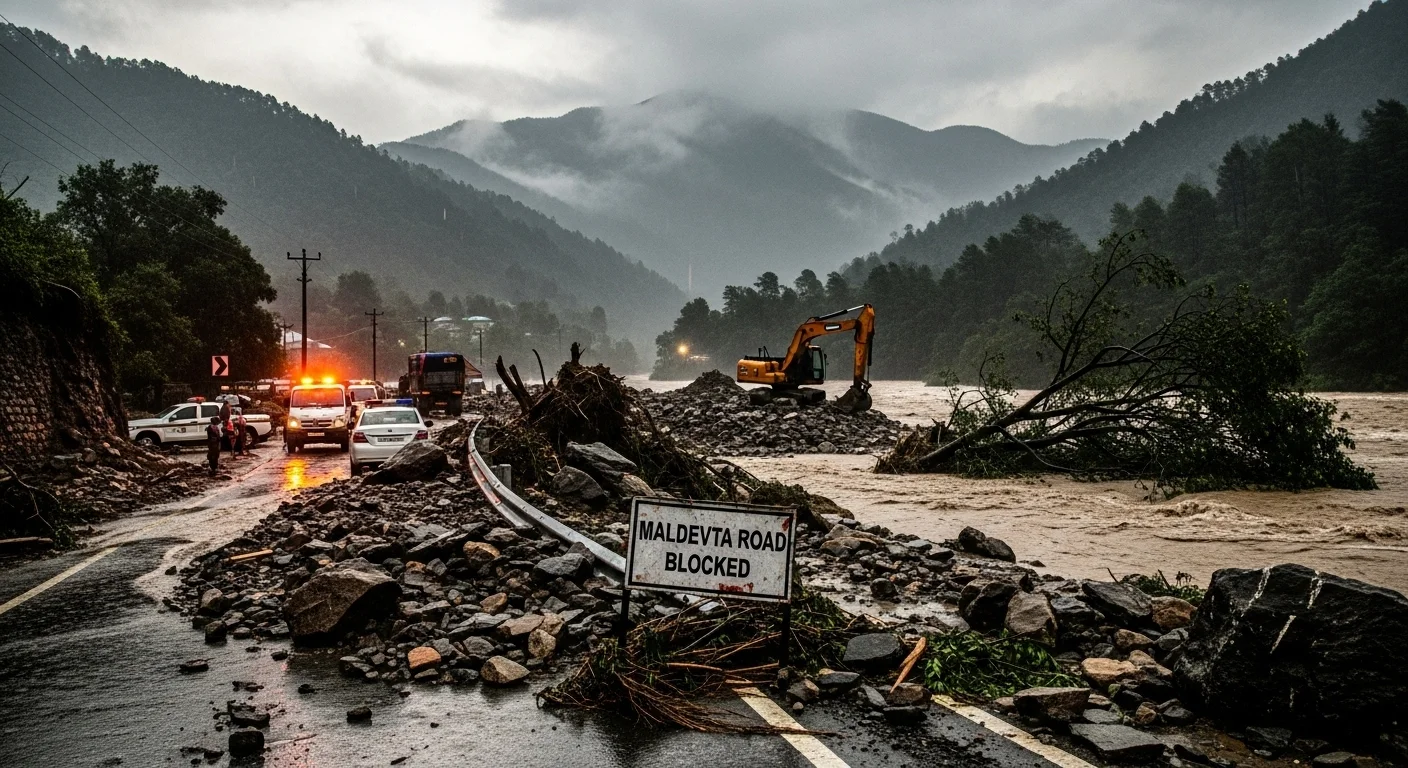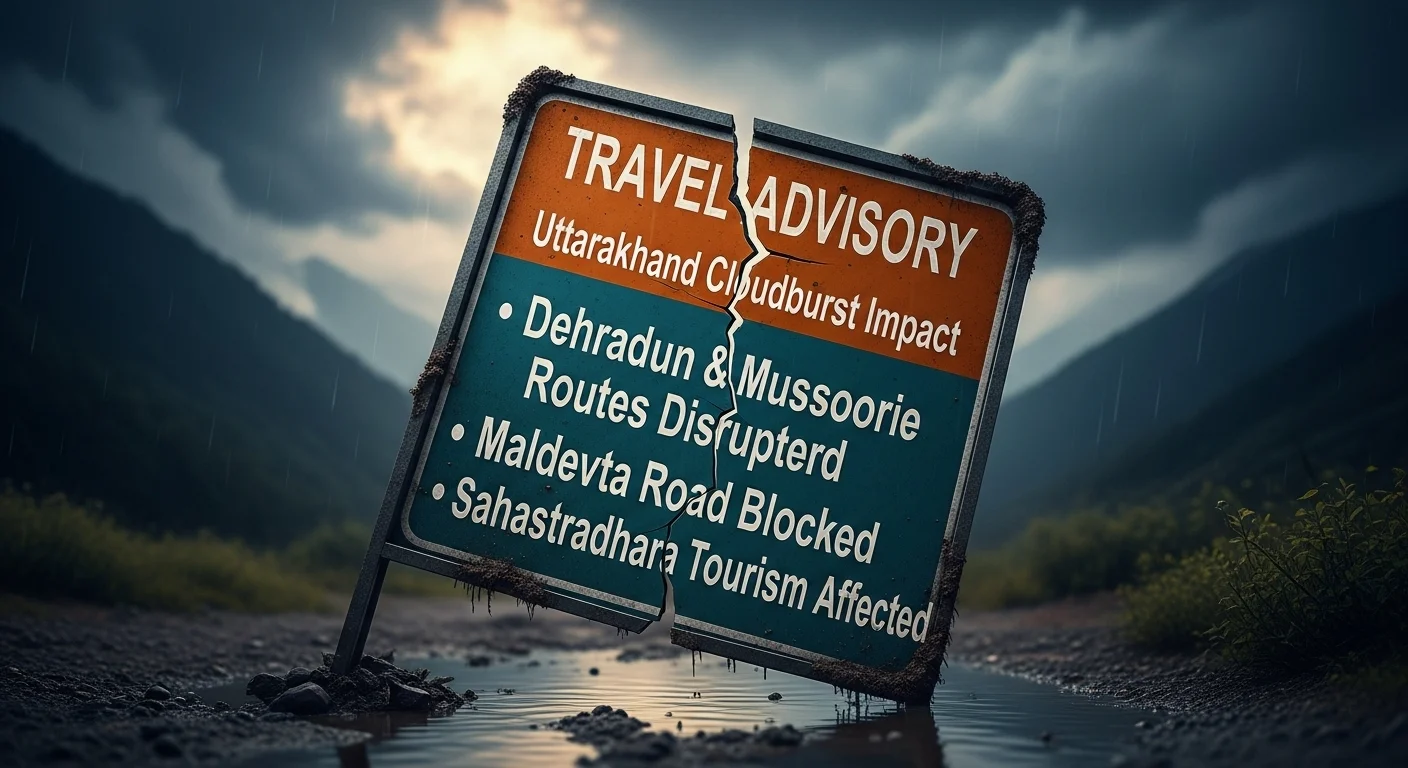Uttarakhand, a state known for its serene hills and spiritual sites, has once again been shaken by the unpredictable fury of nature. The recent cloudburst in Uttarakhand unleashed a torrent of rainfall, triggering devastating flash floods and landslides across the region. This natural calamity has left a trail of destruction in its wake, causing immense damage to roads, infrastructure, and local life. For those with planned trips, this blog provides a vital Uttarakhand disaster update, detailing the condition of key routes and tourist spots. It is an essential read to understand the gravity of the situation and to make informed decisions about your travel plans.
Ground Zero: The Impact on Dehradun and Surrounding Areas
The Doon Valley, including the state capital Dehradun, bore the brunt of the heavy rains. The sudden deluge caused widespread destruction, particularly in areas near riverbanks and streams. Villages, homes, and commercial establishments were either damaged or completely swept away by the gushing waters.

- Maldevta Road Blockage: One of the most severely affected areas was Maldevta, a popular picnic and getaway spot. The raging Song River, swollen by the cloudburst, completely washed away a portion of the road. Consequently, the Maldevta road blocked status remains in effect, severing a critical link and halting all vehicular movement in the area. Restoration efforts are underway, but the damage is extensive and will likely take time to repair.
- Sahastradhara Tourism Affected: The beloved tourist destination of Sahastradhara has been devastated. The Sahastradhara tourist spot update reveals a grim picture, with floodwaters and debris causing immense damage. The local market, which was home to numerous shops, resorts, and restaurants, has been ravaged. While it was fortunate that no tourists were present due to the monsoon season, the livelihoods of many local shopkeepers and hoteliers have been severely impacted.
- Other Blocked Routes: The damage wasn’t confined to these two spots alone. Other crucial arteries have also been affected by the cloudburst in Uttarakhand. The Dehradun-Haridwar Highway near Lal Tappar experienced a bridge collapse, severely disrupting traffic. Landslides and rockfalls have also been reported on the route connecting to Chakrata Road, further complicating the Dehradun road status for commuters and travelers.
The State of Mussoorie Routes: A Hill Station Cut Off

Mussoorie, often called the “Queen of Hills,” has been virtually cut off from the state capital due to multiple landslides and washed-out roads. All major routes leading to the hill station from Dehradun are completely disrupted, making travel impossible.
- Specific Road Conditions: The main Dehradun-Mussoorie Road, which is the lifeline for the hill station, has been severely damaged. Sections of the road near Shiv Mandir and Kolhukhet have been completely washed away, leaving deep chasms. The authorities have deemed the Mussoorie road condition too perilous for any vehicular movement until extensive repairs are completed.
- Alternative Routes: The situation is no better on alternative access points. The route via Kimadi, which often serves as a detour, has also been blocked by landslides. Similarly, all other access points, including those from Dhanaulti, have been compromised, essentially isolating the hill station from the rest of the state.
- Stranded Tourists: The road blockage in Uttarakhand has left a large number of tourists stranded in Mussoorie. Many were unable to check out of their hotels and begin their return journey. Local authorities and hotel associations are working to ensure the stranded visitors have safe accommodation and access to essential supplies until the routes are cleared.
Current Status and Travel Recommendations
The Uttarakhand flash floods have prompted a swift response from state authorities. Rescue and relief operations are being carried out on a war footing by the SDRF (State Disaster Response Force) and NDRF (National Disaster Response Force). Chief Minister Pushkar Singh Dhami has conducted on-site inspections and directed officials to expedite road clearing and restoration efforts.
- Road Status Updates: While work is in progress, the Dehradun road status and Mussoorie road condition remain critical. Authorities are using heavy machinery to clear debris and repair damaged sections. However, the continuous threat of rain and further landslides is hampering progress. It is advised to monitor official channels for real-time updates before planning any movement.
- Monsoon Travel Risks: This recent calamity is a stark reminder of the inherent risks of Monsoon travel Uttarakhand. The state is highly susceptible to cloudbursts, flash floods, and landslides during this period. Travelers must understand that while the monsoon season offers lush green landscapes and stunning vistas, it also brings a heightened risk of road closures and travel disruption.
Travel Advisory for Dehradun & Mussoorie
If you are currently in Uttarakhand or planning a trip soon, follow this travel advisory for Dehradun & Mussoorie:
- Avoid Non-Essential Travel: It is highly recommended to postpone any non-essential travel to and from Dehradun and Mussoorie until the situation stabilizes.
- Monitor Weather Forecasts Every Day: Always adhere to the Indian Meteorological Department (IMD) as well as local dailies prior to embarking on your trip.
- Don’t Travel at Night: Landslides and road closures are more difficult to notice in the dark, raising risks.
- Be Aware: Have emergency contacts in hand and a charged telephone along with a power bank.
- Book Safe Shelter: Pick hotels which are not located near riversides, steep hillsides, or recognized landslide-risk zones.
- Travel Light but Intelligently: Pack items such as dry food, medications, water, warm clothing, and rain wear.
- Heed Official Advisories: Obey roadblock orders and safety alerts issued by police and disaster management authorities.
- Opt for Registered Transport: Opt for government-sanctioned taxis or buses over unlicensed private services.
- Be Flexible with Plans: Be prepared to postpone or rebook your journey if the weather deteriorates.
- Stay Informed: Always check for the latest weather and road conditions from official sources before starting your journey.
- Safety First: When in the region, avoid traveling after dusk. Do not attempt to cross swollen rivers or streams.
- Travel to Dehradun and Mussoorie: It is currently not advisable due to the extensive damage and ongoing risks.
This travel advisory for Dehradun & Mussoorie isn’t just about avoiding inconvenience—it’s about ensuring your safety in unpredictable conditions.
Government and Rescue Operations
The Uttarakhand Cloudburst Impact has prompted swift action by state authorities. Disaster response teams, police, and local volunteers are clearing blocked roads, setting up relief camps, and distributing essentials to stranded people.
Restoration of Maldevta Road blocked and reopening of Mussoorie routes disrupted are top priorities. Rescue teams have also been deployed to assist children, elderly residents, and tourists stuck in affected areas.
Lessons from the Cloudburst
The Uttarakhand Cloudburst Impact underlines the need for better preparedness and respect for natural forces. While the Himalayas offer unmatched beauty, they are also prone to extreme weather events. Travelers should:
- Avoid visiting during peak monsoon (July–September).
- Always carry weather gear and emergency kits.
- Stay cautious in eco-sensitive and landslide-prone zones.
- Practice sustainable tourism and avoid littering.
Over the long term, Uttarakhand will need stronger infrastructure, improved drainage systems, and stricter tourism regulations in sensitive regions.
Conclusion
The recent cloudburst has once again tested the resilience of the local community and the region’s infrastructure. While the damage is extensive, the swift response from the authorities and the perseverance of the locals offer a glimmer of hope. The ongoing efforts aim to restore normalcy, but the event serves as a crucial warning for travelers to exercise extreme caution when planning their trip to the hills during the monsoon season.
FAQs (Frequently Asked Questions)
Q1. Is it safe to travel to Dehradun and Mussoorie right now?
Ans: No, it is currently not safe for non-essential travel. Heavy rains and a cloudburst have caused widespread road blockage in Uttarakhand and multiple landslides, with major routes to both Dehradun and Mussoorie being completely cut off.
Q2. What is the latest status of the roads to Mussoorie?
Ans: The main Dehradun-Mussoorie road and its alternative routes are severely affected by landslides. The Mussoorie road condition is currently impassable, and authorities are working to clear the debris, but travelers should not attempt to use these routes for now.
Q3. What is the situation at Maldevta and Sahastradhara?
Ans: Both tourist spots have been severely impacted. The Maldevta road blocked status remains, and the Sahastradhara tourist spot update shows it has been devastated by floodwaters, with many shops and hotels washed away. These areas should be avoided.
Q4. Are there any other areas affected by the cloudburst?
Ans: Yes, the Uttarakhand flash floods have caused damage in many other areas. Roads near Chakrata and on the Dehradun-Haridwar highway have also been affected, and many local bridges and culverts are damaged.
Q5. What should I do if I am already in the region?
Ans: If you are in the region, it is essential to stay in your hotel or a safe location. Do not attempt to travel. Keep a close eye on the official Uttarakhand travel advisory and weather alerts. Avoid venturing near riverbanks or landslide-prone areas.
Thank you for trusting Outdoorkeeda as your guide for your travel needs. 🙏







